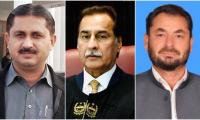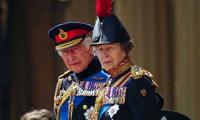Watching Narendra Modi’s recent marathon performance in the Indian parliament had been a surreal experience. Angry, bitter and vengeful, he did not speak like the confident leader of a party that has enjoyed four years of absolute power. It was more like the cynical harangue of a frustrated politician who has spent many long years out of power and in ignominy.
Modi spoke for nearly two-and-a-half hours and much of his speech was devoted to the Congress, a party that barely has 48 members in parliament against the staggering 300-plus strength of the ruling BJP and NDA.
Modi’s party doesn’t just rule from Delhi. It is in power in 19 states across the length and breadth of the country whereas the grand old party of Gandhi and Nehru’s pedigree has been reduced to a couple of states like Punjab and Karnataka. This is perhaps the lowest that the Congress has fallen in its long history; and yet the PM and his Parivar remain obsessed with the opposition party now headed by Rahul Gandhi.
In his long and gruelling speech in the two houses of parliament, Modi made at least a dozen direct attacks on the Gandhis, including those who aren’t around. It has been 70 years since India’s independence and more than half a century since Nehru’s death in 1964. During this period, the BJP has been in power for the past four years – not to forget its earlier stint under Vajpayee. But all Modi talks about is a down-and-out Congress from every possible platform, including during foreign sojourns.
During the 2014 elections, he gave the call for a ‘Congress-Mukt Bharat’ (a Congress-free India). Over the past four years, he and other BJP bigwigs have made the same pitch ad nauseam without raising the hackles of the Election Commission. Even the Congress seems to have taken it in its stride without protesting the open calls for its decimation.
In any other country, this would have sparked spontaneous protests. Can we imagine the Republicans calling for a ‘Democrat-free America’? This would be unthinkable even under Donald Trump. The February 7 ‘address to the nation’ would go down in parliament’s history as perhaps the most rancorous one – even from the lofty standards set by the BJP.
Modi spoke like a combative prosecutor in a packed courtroom, recounting each and every crime of those in the dock and blaming the Congress (read: the Gandhis) for all of the nation’s woes. While the late mother-son duo of Indira and Rajiv Gandhi incurred his wrath for the Emergency and 1984 anti-Sikh pogrom, respectively, he tore into Sonia Gandhi, Rahul Gandhi and Dr Manmohan Singh for corruption and the mishandling of issues like Telangana. However, his choicest attacks had been reserved for Jawaharlal Nehru, the charismatic first prime minister and the architect of modern, democratic India.
For far too long, the Parivar has blamed Nehru for a series of ‘historic blunders’ – from the partition of India to the ‘mishandling’ of Kashmir and from the ‘abject surrender’ to China to the deliberate ‘humiliation’ of Sardar Patel. So why does the Parivar love Nehru so much?
Since it came to power, the BJP has been pursuing a clever strategy of hijacking national icons such as Gandhi, Patel and even the Dalit icon Dr Ambedkar, the father of Indian constitution who despised Hinduism and its caste hierarchy. On the other hand, it has been relentlessly attacking Nehru and chipping away at his awesome legacy. The architect of modern India and easily its tallest leader after Gandhi is being portrayed as a weak, indecisive man with feet of clay and ‘corrupt morals’.
They have sought to pit Patel, with his anti-Muslim image, against Nehru, projecting him as an abler leader who should have – in their view – succeeded Gandhi as the leader of an independent India. Modi, who has sought to fashion himself in the mould of the ‘iron man’, has repeatedly bemoaned the fact that Patel could not lead India after Independence.
The Hindu Right undoubtedly shares a sense of ideological kinship with Patel. In 1966, MS Golwalkar, the RSS supremo, wrote in his book ‘Bunch of Thoughts’: “We were fortunate that we had in Sardar Patel a person with an iron will to face the reality in those days”.
Patel, a religious conservative at heart and perhaps the first practitioner of ‘soft Hindutva’ admired the RSS as a “socio-cultural” organisation and its members as “patriots who love their country”. Three weeks before Gandhi’s assassination, Patel even invited RSS workers to join the Congress. However, things dramatically changed after the Mahatma’s assassination, which was carried out by Nathuram Godse, a Hindu Mahasabha-RSS veteran.
Of course, the RSS quickly disowned Godse and the fact that its ideology of hate and propaganda demonising Gandhi and accusing him of being ‘soft’ on Muslims led to his killing was not sufficiently proved in the court. But it hardly remained a secret who inspired and was, directly or indirectly, responsible for the assassination of the Mahatma.
No wonder Patel was forced to ban the RSS. In a letter to Jan Sangh founder Shyama Prasad Mukherjee, Patel wrote: “As a result of the activities of these two bodies [the RSS and the Hindu Mahasabha], particularly the former, an atmosphere was created in the country in which such a ghastly tragedy became possible. There is no doubt the extreme section of the Hindu [Mahasabha] was involved in this conspiracy. The activities of the RSS constituted a clear threat to the existence of the [g]overnment and the [s]tate”.
Surprisingly, Patel withdrew the RSS ban only a year-and-a-half later, with a warning that the RSS would not take part in politics. But within a year, the RSS floated the Jan Sangh, which would later be replaced by the BJP under the leadership of Vajpayee and Advani.
No wonder the Parivar feels so indebted to Patel. However, there is more to it than mere love for a man who, after Partition, bluntly told India’s Muslims to “behave” or go to Pakistan, and presided over the Hyderabad ‘police action’ that resulted in thousands of killings and worse.
Behind the BJP’s hatred for Nehru and the appropriation of icons like Gandhi, Patel and Ambedkar lies the Hindutva stratagem to paper over its own role – or lack thereof – in India’s freedom struggle on the one hand and reimagine the national narrative from a Hindutva perspective as against Nehru’s pluralist approach on the other.
Nehru’s formidable legacy towers over and stands against everything that Hindutva represents. The Parivar knows full well that without demolishing Nehru’s legacy, it cannot succeed in reshaping the idea of India. For the country we know as India today was built on the vision of its first prime minister.
If India bucked the trend in the region and grew into a secular, tolerant and multicultural democracy, with a benevolent state pursuing balanced growth and looking out for its poor and dispossessed, the credit largely goes to Nehru. Leading the young nation in its formative years, Nehru defined India’s identity, charted its trajectory of growth, informed its worldview and shaped its national character. Urbane, liberal and staunchly secular, Nehru fashioned the young, emerging nation in his own image.
It was under Nehru that India took long and decisive strides on the path of development and growth. He built a progressive nation that took pride in its diversity and pluralist traditions. He still stands tall today, towering above everyone else thanks to the indelible imprint that he has left on the country and its institutions. More importantly, Nehru and his powerful legacy, seen in the strong political and democratic institutions of the country, remain a stumbling block in the way of the Parivar’s ambitions to paint India saffron.
If the Parivar’s idea of the Hindu Rashtra is to take shape, Nehru’s idea of an inclusive India must die. But in trying to obliterate Nehru’s legacy, Hindutva may end up unmaking India.
The writer is an independent writer and former newspaper editor.
Email: aijaz.syed@hotmail.com
A woman walks past a building of the International Monetary Fund. — AFP/FileThe annual and spring meetings of the...
Late Benazir Bhutto's daughter Asifa Bhutto Zardari addresses the Christian community in Bihar Colony on January 23,...
Representational image. — PexelsWater is an important scarce natural resource that is required for several everyday...
Pakistani employees of online marketplace company Kaymu at work in Karachi. — AFP/FileThe true spirit of development...
India uses Afghanistan as a backstage area to carry out terrorist attacks against Pakistan
Another report by the Pakistan Institute of Peace Studies states that 78 per cent of attacks have been carried out by...







